การพัฒนารูปแบบการปรับเปลี่ยนพฤติกรรมตามทฤษฎีโซลูชั่น-โฟกัสผ่านแอพพลิเคชั่นไลน์ของผู้ที่อยู่ในภาวะก่อนเบาหวาน
Main Article Content
บทคัดย่อ
ที่มาของปัญหา: ผู้ที่อยู่ในภาวะก่อนเบาหวานมีอุบัติการณ์ที่เพิ่มสูงขึ้นอย่างต่อเนื่อง และส่งผลให้เกิดภาวะแทรกซ้อนตามมา จากสถิติในปี พ.ศ. 2563 พบว่า จังหวัดจันทบุรี มีผู้ที่อยู่ในภาวะก่อนเบาหวานมากที่สุดในเขตสุขภาพที่ 6 ดังนั้น ผู้ป่วยกลุ่มนี้จึงควรได้รับการปรับเปลี่ยนพฤติกรรมอย่างเหมาะสม เพื่อชะลอการเกิดโรคในอนาคต
วัตถุประสงค์: พัฒนาและศึกษาผลของการพัฒนารูปแบบการปรับเปลี่ยนพฤติกรรมด้วยทฤษฎีโซลูชั่น-โฟกัสผ่านแอพพลิเคชั่นไลน์ของผู้ที่อยู่ในภาวะก่อนเบาหวาน
วิธีการศึกษา:เป็นการวิจัยเชิงปฏิบัติการแบบมีส่วนร่วม กลุ่มตัวอย่างที่ใช้ในการศึกษาครั้งนี้ ประกอบด้วย ผู้ที่อยู่ในภาวะก่อนเบาหวานในเขตรับผิดชอบของโรงพยาบาลส่งเสริมสุขภาพตำบลจันทนิมิต จำนวน 30 คน เครื่องมือที่ใช้ในการเก็บรวบรวมข้อมูล ประกอบด้วย แบบสอบถามข้อมูลทั่วไป แบบบันทึกภาวะสุขภาพ แบบประเมินความรอบรู้ด้านสุขภาพและพฤติกรรมสุขภาพตามหลัก 3อ. 2ส. แบบประเมินพฤติกรรมการดูแลตนเอง การวิเคราะห์ข้อมูลด้วยการวิเคราะห์เชิงเนื้อหา สถิติพรรณนา และสถิติ Paired-sample t-test
ผลการศึกษา: การพัฒนารูปแบบฯ ประกอบด้วย 4 ระยะ ดังนี้ ระยะที่ 1 ศึกษาสภาพการณ์ปัจจุบัน และวิเคราะห์ปัญหาการปรับเปลี่ยนพฤติกรรมของผู้ที่มีภาวะก่อนเบาหวาน ในโรงพยาบาลส่งเสริมสุขภาพประจำตำบลจันทนิมิต จากการอภิปรายของหัวหน้า รพ.สต. เจ้าหน้าที่ รพ.สต. พยาบาลวิชาชีพ 5 คน อสม. 10 คน ผู้ที่มีภาวะก่อนเบาหวาน 20 คน ระยะที่ 2 วางแผนการพัฒนารูปแบบการปรับเปลี่ยนพฤติกรรมสำหรับผู้ที่มีภาวะก่อนเบาหวาน โดยใช้แนวคิดทฤษฎี Solution-Focused Brief Theory ระยะที่ 3 การใช้รูปแบบการปรับเปลี่ยนพฤติกรรมโดยใช้แอพพลิเคชั่นไลน์ และการกำกับติดตามการดำเนินงาน และระยะที่ 4 ประเมินผลการใช้รูปแบบติดตามประเมินผลการปรับเปลี่ยนพฤติกรรม ผลการวิจัย พบว่า ค่าเฉลี่ยรอบเอว ค่าเฉลี่ยดัชนีมวลกาย (BMI) และค่าเฉลี่ยระดับน้ำตาลในเลือด หลังเข้าร่วมการปรับเปลี่ยนพฤติกรรมมีค่าลดลงอย่างมีนัยสำคัญทางสถิติ (p<0.001) หลังเข้าร่วมการวิจัยฯ กลุ่มตัวอย่างมีค่าเฉลี่ยของความรอบรู้ด้านสุขภาพและพฤติกรรมสุขภาพมากกว่าก่อนทดลอง อย่างมีนัยสำคัญทางสถิติ (p<0.001)
สรุป: รูปแบบการปรับเปลี่ยนพฤติกรรมตามทฤษฎีโซลูชั่น-โฟกัสผ่านแอพพลิเคชั่นไลน์นี้ สามารถนำไปเป็นแนวทางในการเพิ่มประสิทธิภาพการปรับเปลี่ยนพฤติกรรมของผู้ที่มีภาวะก่อนเบาหวาน เพื่อชะลอการเกิดโรคเบาหวานและลดภาวะแทรกซ้อนได้
Article Details

อนุญาตภายใต้เงื่อนไข Creative Commons Attribution-NonCommercial-NoDerivatives 4.0 International License.
เอกสารอ้างอิง
Kanchanapibulwong A, Khamwangsanga P, Kaewtha S. Reports on the situation of NCDs: diabetes, high blood pressure and related risk factors. Nonthaburi: Division of Non-Communicable Diseases, Department of Disease Control, Ministry of Public Health; 2019.
Health Information Center, Health Area 6. QOF63 01 Percentage of people who were screened and diagnosed with diabetes [Internet]. 2023 [cited 2022 Oct 2]. Available from: http://zone6.cbo.moph.go.th/phi/report/view/?repid-link=384&cat-link=122
Rongmuang D. Applying health promotion theories for behavioral modification to prevent and control obesity. J Prapokklao Hosp Clin Med Educat Center 2018; 35:77-91.
Nitirat P, Pisaipan P, Rongmuang D, Lekwong S. Effects of mixed-theory based model for behavioral modification on the perception toward self-efficacy in self-management and the reduction of chronic disease risks among professional and non professional staffs in Phrapokklao College of Nursing, Chanthaburi, Thailand. J Prapokklao Hosp Clin Med Educat Center 2018; 35:18-29.
Muangngern Y. Nursing guide behavior modification in adults with pre-diabetes type 2 diabetes. Bangkok: Outpatients screening work, nursing department Siriraj Hospital; 2019.
deShazer S, Dolan Y, Korman H, Trepper T, Mccollum E, Berg IK. More than Miracles: the state of the art of solution-focused brief therapy. 2nded. New York: Routledge; 2021.
Shuttlewood E, Nash J. A solution-focused approach to diabetes-related distress. Journal of Diabetes Nursing 2016; 20:102-7.
Prasertsong C. The applied solution-focused brief therapy in family nursing. Royal Thai Army Nursing Journal 2015; 16(2):1-7.
Ahmadi Z, Bazzazian S, Tajeri B, Rajab A. Effectiveness of solution-based therapy on self-compassion and reducing blood glucose in elderly patients with type 2 diabetes. Avicenna J Neuro Psycho Physiology 2020; 7:151-7.
VanVoorhis CR, Morgan BL. Understanding power and rules of thumb for determining sample sizes. Tutorials in Quantitative Methods for Psychology 2007; 3(2):43‐50.
Khunraksa S,Chadngern K. Development of a health behavior modification process for public health officer Bangpakong Hospital. Journal of NarathiwatRajanagarindra University 2021; 13(2):106-24
IntarakamhangU. Complete Report on Creating and Developing of Thailand Health Literacy Scales [internet]. [cited 2022 Sep 8], Nonthaburi: Division of Health Education, Department of Health Service Support, Ministry of Public Health;2017. Available from: http://bsris.swu.ac.th/upload/268335.pdf
Nutbeam D. Health literacy as a population strategy for health promotion. JJHEP 2017; 25(3):210-22.
Guyers M, Simm R, Bray D. Doing diabetes differently: An overview of solution-focused approaches in pediatric diabetes care. Diabetes Care for Children & Young People [Internet]. 2019 [cited 2022 Oct 2];9:39. Available from: https://diabetesonthenet.com/wp-content/uploads/pdf/dotna44613a248fca389857b818921b8f0ee.pdf
Greenwood DA, Ross TA, Reifsnider E. Applying a solution-focused approach to life with diabetes: insights gleaned via twitter. Diabetes Educ 2020; 46:485-94.
Valve P,Lehtinen-Jacks S, Eriksson T,Lehtinen M, Lindfors P, Saha MT, et al. LINDA-a solution-focused low-intensity intervention aimed at improving health behaviors of young females: a cluster-randomized controlled trial. BMC Public Health [Internet].2013[cited 2022 Oct 2]; 13:(1044). Available from: https://bmcpublichealth.biomedcentral.com/articles/10.1186/1471 2458-13-1044

